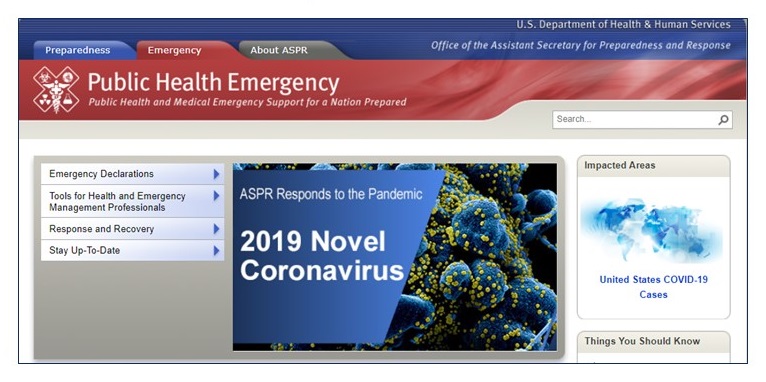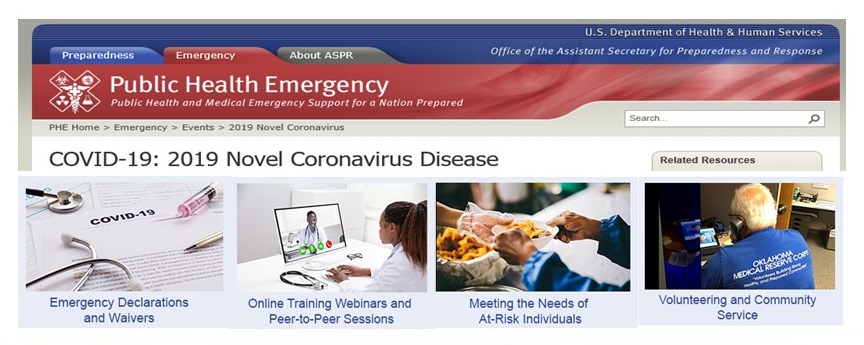Monday, July 20, 2020
Printer Friendly Version in PDF Format (8 PDF pages)
At-Risk Individuals Program and COVID-19
Cheryl A. Levine, PhD
Senior Advisor, At-Risk Individuals Program Director
Assistant Secretary for Preparedness and Response (ASPR)
US Department of Health and Human Services (HHS)
Background on ASPR
 |
| https://www.phe.gov/emergency/pages/default.aspx |
ASPR Mission
Save Lives and Protect Americans from 21st Century Health Security Threats
ASPR/At-Risk Individuals (ARI) Program
- COVID-19 Response -- HHS/FEMA Community Mitigation Workgroup
- Team includes 2 ASPR/ARI personnel and multiple COVID-19 Rotations
HHS Requirements for At-Risk Individuals
- The Public Health Service Act (https://www.phe.gov/Preparedness/planning/authority/Pages/default.aspx) forms the foundation of HHS’ legal authority for responding to public health emergencies as amended by the 2019 Pandemic And All-Hazards Preparedness and Advancing Innovation Act (PAHPAIA) (https://www.phe.gov/Preparedness/legal/pahpa/Pages/pahpaia.aspx).
- Pandemic and All-Hazards Preparedness and Advancing Innovation Act (2019) updated language under the Public Health Service Act (PHSA)
- Section 2802 requires taking into account the public health and medical needs of at-risk individuals. It defines at-risk individuals as children, pregnant women, older adults, individuals with disabilities, and others who may have access or functional needs in the event of a public health emergency as determined by the Secretary of Health and Human Services.
Access and Functional Needs (AFN) Population
- Children
- People Who Live in Institutional Settings
- Older Adults
- Pregnant Women
- People with Disabilities
- People with Chronic Conditions
- People with Pharmacological Dependency
- People with Limited Access to Transportation
- Limited English Proficiency/Non-English Speakers
- People with social and economic limitations
- Individuals Experiencing Homelessness
At-Risk Individuals, Behavioral Health & Community Resilience (ABC) Library -- Older Adults
- HHS/ASPR Access and Functional Needs Web-Based Training https://www.train.org/main/course/1083869/
- Defines the concept of “access and functional needs” (or AFN) of at-risk individuals including older adults, people with disabilities, people with chronic health conditions, etc.
- Approach for addressing a common AFN irrespective of specific diagnoses, status, or labels
- Tools for addressing AFN during disaster preparedness, response, and recovery activities
- Working with Older Adults and People with Disabilities: Tips for Treatment and Discharge Planning https://www.phe.gov/Preparedness/planning/abc/Pages/elderly-disabled.aspx
- Considerations for public health planners and emergency responders when older adults require temporary placement in a healthcare facility during a public health emergency
- Steps to take to ensure discharge planning is person-centered and places these individuals in the least restrictive environment that meets their needs
Capacity-Building Toolkit
- Version 2.0 published June 17th, 2020
- HHS: ASPR & ACL
- National Association of County and City Health Officials (NACCHO)
- Association of State and Territorial Health Officials (ASTHO)
Purpose of the Capacity-Building Toolkit
- Ensure equal access to our nation’s emergency preparedness, response and recovery resources
- Provide information and resources for the Aging and Disability Networks to become more engaged in emergency planning (CBO Readiness)
- Advance whole community planning and supporting consumers (Consumer Planning)
- Develop partnerships with emergency management and public health officials (Partnership)
Emergency Planning for Organizations
- Identify hazards
- Conduct risk assessments
- Create an Emergency Operations Plan
- Understand the Incident Command System (ICS)
- Understanding the Emergency Support Functions (ESF)
- Participate in trainings and exercises
- Engage in consumer advocacy
- Participation in exercises
- Inclusion in emergency plans
| Figure 1: The Phases of Emergency Management |
|---|
|
COVID-19 ARI Activities to Date
- Foster relationships with new and existing stakeholders
- Collaborate with partners to create and promote resources and guidance
- Support expanding and maintaining of nutritional resources
- Develop journey maps and other resources for providers serving AFN population
Sustaining Nutritional Needs for At-Risk Individuals
- Guidance for federal agencies and state, local and territorial governments to sustain and expand home delivered meals and other nutrition programs through:
- Identifying need
- Building capabilities
- Engaging networks
- Creating solutions
- Provides information on leading practices and existing programs that provide nutrition services for at-risk individuals
- Includes overview of government programs that address nutritional needs
ARI Program: Recent and Forthcoming Products
- Recent (COVID-19 Response Resources:
- Sustaining Nutritional Needs for ARIs https://www.phe.gov/emergency/events/COVID19/atrisk/Documents/sustaining-nutritional-needs-atrisk-individuals-v2.pdf
- Federal Programs to Sustain Nutrition for ARIs https://www.phe.gov/emergency/events/COVID19/atrisk/Documents/Federal-Homelessness-Programs-v2.pdf
- Returning to Work for Community Based Organizations https://www.phe.gov/emergency/events/COVID19/atrisk/returning-to-work/Pages/default.aspx
- Forthcoming:
- Adults with Disabilities in Community Settings
- HHS/ASPR/At-Risk Individuals Program and Federal Partners: Telehealth and CBOs Webinar Series
- HHS/ASPR Addressing the Needs of Older Adults in Disasters: Web-Based Training (TRAIN Learning Network)
- Replacing Durable Medical Equipment & Prescription Drugs after a Disaster: Addressing the Needs of Medicare Beneficiaries (ASPR & CMS)
COVID-19: Novel Coronavirus Disease
Information about ASPR’s efforts to protect the nation from this novel disease are available online at https://www.phe.gov/emergency/events/COVID19/Pages/default.aspx.
 |
